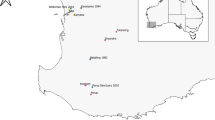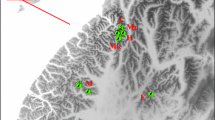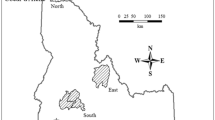Abstract
Hormonally-induced fertility control is increasingly used to manage overabundant wildlife where political or ethical considerations exclude culling or translocations. By altering reproductive rates, fertility control risks accelerating the loss of genetic variation from isolated wildlife populations if control is biased against particular genotypes. This is most likely in spatially structured populations, but information on patterns of genetic exchange can be difficult to ascertain by observation or trapping. Fertility control was proposed to manage an isolated but overabundant population of the black-flanked rock-wallaby, Petrogale lateralis lateralis, at Mt Caroline Nature Reserve, south-western Australia. This species typically inhabits large granite outcrops, where refuges within outcrops are often patchily distributed, and there is strong potential for population structure. We used fine-scale analysis of microsatellite DNA variation to establish the pre-fertility control extent of population structuring and the relative extent of gene flow in males and females in an isolated population of black-flanked rock-wallabies. Bayesian model-based clustering and fixation statistics revealed that overall gene flow is extensive, but two areas of refuge were genetically distinct from distant neighbours. Spatial autocorrelation analyses indicated that female-mediated gene flow was less extensive than male-mediated gene flow. Our results indicate that it would be desirable to apply fertility control to female rock wallabies within defined genetic isolates, but fertility control could be applied in a spatially random manner to males.




Similar content being viewed by others
References
Adderton Herbert C (2004) Long-acting contraceptives: a new tool to manage overabundant kangaroo populations in nature reserves and urban areas. Aust Mammal 26:67–74
Anon (1994) Resolution for comment: wildlife contraception. In: AAWV Newsletter, August 1994, vol August 1994, pp 3–4, American Association of Wildlife Veterinarians, USA, pp 3–4
Anselin L (1995) Local indicators of spatial association: LISA. Geogr Anal 27:93–115
Bayliss P (1985) The population dynamics of red and western grey kangaroos in arid New South Wales, Australia. 1. Population trends and rainfall. J Anim Ecol 54:111–125
Bertschinger HJ, Guimarães MABV, Trigg TE, Human A (2008) The use of deslorelin implants for the long-term contraception of lionesses and tigers. Wildl Res 35(6):525–530. doi:10.1071/WR07141
Browning TL, Taggart DA, Rummery C, Close RL, Eldridge MDB (2001) Multifaceted genetic analysis of the “Critically Endangered” brush-tailed rock-wallaby Petrogale penicillata in Victoria, Australia: implications for management. Conserv Genet 2(2):145–156
Caughley G, Pech R, Grice D (1992) Effect of fertility control on a population’s productivity. Wildl Res 19:623–627
Chesser RK (1991a) Gene diversity and female philopatry. Genetics 127:437–447
Chesser RK (1991b) Influence of gene flow and breeding tactics on gene diversity within populations. Genetics 129:573–583
Cowan PE, Tyndale-Biscoe CH (1997) Australian and New Zealand mammal species considered to be pests or problems. Reprod Fertil Dev 9(1):27–36. doi:10.1071/R96058
Dobson FS, Chesser RK, Hoogland JL, Sugg DW, Foltz DW (1998) Breeding groups and gene dynamics in a socially structured population of prairie dogs. J Mammal 79:671–680
Double MC, Peakall R, Beck NR, Cockburn A (2005) Dispersal, philopatry, and infidelity: dissecting local genetic structure in superb fairy-Wrens (Malurus cyaneus). Evolution 59(3):625–635
Eldridge MDB, Close RL (1997) Chromosomes and evolution in rock-wallabies Petrogale (Marsupialia: Macropodidae). Aust Mammal 19:123–135
Eldridge MDB, Pearson DJ (2008) Black-footed rock-wallaby. In: van Dyck S, Strahan R (eds) The mammals of Australia, 3rd edn. New Holland, Reed, pp 376–380
Eldridge MDB, Kinnear JE, Onus ML (2001) Source population of dispersing rock-wallabies (Petrogale lateralis) identified by assignment tests on multilocus genotypic data. Mol Ecol 10(12):2867–2876
Epperson BK, Li T (1996) Measurement of genetic structure within populations using Moran’s spatial autocorrelation statistics. Proc Nat Acad Sci USA 93:10528–10532
Evanno G, Regnaut S, Goudet J (2005) Detecting the number of clusters of individuals using the software structure: a simulation study. Mol Ecol 14(8):2611–2620
Excoffier L, Smouse PE, Quattro JM (1992) Analysis of molecular variance inferred from metric distances among DNA haplotypes: application to human mitochondrial DNA restriction sites. Genetics 131:479–491
Fagerstone KA, Coffey MA, Curtis PD, A. DR, J. KG, Miller LA, Wilmot LM (2002) Wildlife fertility control—the wildlife society. Technical Review 02-2
Falconer DS (1989) Introduction to quantitative genetics, 3rd edn. Longman, London
Hawken RJ, Maccarone P, Toder R, Marshall-Graves JA, Maddox JF (1999) Isolation and characterization of marsupial IL5 genes. Immunogenetics 49(11):942–948
Hazlitt SL, Eldridge MDB, Goldizen AW (2004) Fine-scale spatial genetic correlation analyses reveal strong female philopatry within a brush-tailed rock-wallaby colony in southeast Queensland. Mol Ecol 13(12):3621–3632
Hazlitt SL, Goldizen AW, Eldridge MDB (2006a) Significant patterns of population genetic structure and limited gene flow in a threatened macropodid marsupial despite continuous habitat in southeast Queensland, Australia. Conserv Genet 7:675–689
Hazlitt SL, Sigg DP, Eldridge MDB, Goldizen AW (2006b) Restricted mating dispersal and strong breeding group structure in a mid-sized marsupial mammal (Petrogale penicillata). Mol Ecol 15(10):2997–3007
Hazlitt SL, Eldridge MDB, Goldizen AW (2010) Strong matrilineal structuring in the brush-tailed rock-wallaby confirmed by spatial patterns of mitochondrial DNA. In: Coulson G, Eldridge MDB (eds) Macropods: the biology of kangaroos, wallabies and rat-kangaroos. CSIRO Publishing, Melbourne
Herbert CA (2007) From the urban fringe to the Abrolhos Islands: management challenges of burgeoning marsupial populations. In: Lunney D, Eby P, Hutchings P, Burgin S (eds) Pest or guest—the zoology of overabundance. Royal Zoological Society of New South Wales, Mosman
Herbert CA, Trigg TE, Renfree MB, Shaw G, Eckery DC, Cooper DW (2005) Long-term effects of deslorelin implants on reproduction in the female tammar wallaby (Macropus eugenii). Reproduction 129(3):361–369. doi:10.1530/rep.1.00432
Herbert CA, Trigg TE, Cooper DW (2006) Fertility control in female eastern grey kangaroos using the GnRH agonist deslorelin. 1. Effects on reproduction. Wildl Res 33(1):41–46. doi:10.1071/WR04113
Hood GM (2010) PopTools version 3.2.3. Available on the internet www.poptools.org
Horsup A (1996) The behavioural ecology of the allied rock wallaby, Petrogale assimilis. PhD thesis. James Cook University, Townsville
IUCN (2011) IUCN red list of threatened species. Version 2011.2. www.iucnredlist.org. Accessed 23 Jan 2012
Jarman PJ, Bayne P (1997) Behavioural ecology of Petrogale penicillata in relation to conservation. Aust Mammal 19:219–228
Kinnear JE, Krebs CJ, Pentland C, Orell P, Holme C, Karvinen R (2010) Predator-baiting experiments for the conservation of rock-wallabies in Western Australia: a 25-year review with recent advances. Wildl Res 37(1):57–67. doi:10.1071/WR09046
Koenig WD, Van Vuren D, Hooge PN (1996) Detectability, philopatry, and the distribution of dispersal distances in vertebrates. Trends Ecol Evol 11(12):514–517. doi:10.1016/s0169-5347(96)20074-6
Lohr CA, Mills H, Robertson H, Bencini R (2009) Deslorelin implants control fertility in urban brushtail possums (Trichosurus vulpecula) without negatively influencing their body-condition index. Wildl Res 36(4):324–332. doi:10.1071/WR08050
Manel S, Berthier P, Luikart G (2002) Detecting wildlife poaching: identifying the origin of individuals with bayesian assignment tests and multilocus genotypes. Conserv Biol 16(3):650–659
Manel S, Gaggiotti OE, Waples RS (2005) Assignment methods: matching biological questions with appropriate techniques. Trends Ecol Evol 20(3):136–142. doi:10.1016/j.tree.2004.12.004
Nettles VF (1997) Potential consequences and problems with wildlife contraceptives. Reprod Fertil Dev 9:137–143
Peakall R, Smouse PE (2006) Genalex 6: genetic analysis in Excel. Population genetic software for teaching and research. Mol Ecol Notes 6(1):288–295. doi:10.1111/j.1471-8286.2005.01155.x
Peakall R, Smouse PE, Huff DR (1995) Evolutionary implications of allozyme and RAPD variation in diploid populations of dioecious buffalograss Buchloe dactyloides. Mol Ecol 4(2):135–148
Peakall R, Ruibal M, Lindenmayer DB (2003) Spatial autocorrelation analysis offers new insights into gene flow in the Australian bush rat Rattus fuscipes. Evolution 57(5):1182–1195. doi:10.1111/j.0014-3820.2003.tb00327.x
Pearson DJ, Kinnear JE (1997) A review of the distribution, status and conservation of rock-wallabies in Western Australia. Aust Mammal 19:137–152
Piggott MP, Banks SC, Taylor AC (2006) Population structure of brush-tailed rock-wallaby (Petrogale penicillata) colonies inferred from analysis of faecal DNA. Mol Ecol 15(1):93–105
Pope LC, Sharp A, Moritz C (1996) Population structure of the yellow-footed rock-wallaby Petrogale xanthopus (Gray, 1854) inferred from mtDNA sequences and microsatellite loci. Mol Ecol 5(5):629–640
Potter S, Eldridge M, Cooper S, Paplinska J, Taggart D (2012) Habitat connectivity, more than species’ biology, influences genetic differentiation in a habitat specialist, the short-eared rock-wallaby (Petrogale brachyotis). Conserv Genet 13(4):937–952. doi:10.1007/s10592-012-0342-1
Pritchard JK, Stephens M, Donnelly P (2000) Inference of population structure using multilocus genotype data. Genetics 155(2):945–959
Rice WR (1989) Analyzing tables of statistical tests. Evolution 43(1):223–225
Rutberg AT, Naugle RE (2008) Population-level effects of immunocontraception in white-tailed deer (Odocoileus virginianus). Wildl Res 35(6):494–501. doi:10.1071/WR07128
Rutberg AT, Naugle RE, Thiele LA, Liu IKM (2004) Effects of immunocontraception on a suburban population of white-tailed deer Odocoileus virginianus. Biol Conserv 116(2):243–250
Smouse PE, Peakall R (1999) Spatial autocorrelation analysis of individual multiallele and multilocus genetic structure. Heredity 82(5):561–573
Sokal RR, Wartenberg DE (1983) A test of spatial autocorrelation using an isolation-by-distance model. Genetics 105:219–237
Spencer PBS, Odorico DM, Jones SJ, Marsh HD, Miller DJ (1995) Highly variable microsatellites in isolated colonies of the rock-wallaby (Petrogale assimilis). Mol Ecol 4(4):523–525
Sunnucks P, Hales DF (1996) Numerous transposed sequences of mitochondrial cytochrome oxidase I-II in aphids of the genus Sitobion (Hemiptera: Aphididae). Mol Biol Evol 13(3):510–524
Taylor AC, Cooper DW (1998) A set of tammar wallaby (Macropus eugenii) microsatellites tested for genetic linkage. Mol Ecol 7:925–931
Telfer WR, Eldridge MDB (2010) High levels of mitochondrial DNA divergence within short-eared rock-wallaby (Petrogale brachyotis) populations in northern Australia. Aust J Zool 58(2):104–112. doi:10.1071/ZO09119
Underwood JN, Smith LD, van Oppen MJH, Gilmour JP (2007) Multiple scales of genetic connectivity in a brooding coral on isolated reefs following catastrophic bleaching. Mol Ecol 16:771–784
Willers N (2012) Management of isolated populations of black-flanked rock-wallabies (Petrogale lateralis lateralis) using fertility control in Western Australia. PhD thesis, University of Western Australia, Perth, Australia
Willers N, Mawson P, Morris K, Bencini R (2011) Biology and population dynamics of the black-flanked rock-wallaby (Petrogale lateralis lateralis) in the central wheatbelt of Western Australia. Aust Mammal 33:117–127. doi:10.1071/AM10036
Zenger KR, Cooper DW (2001a) Characterization of 14 macropod microsatellite genetic markers. Anim Genet 32(3):166–167
Zenger KR, Cooper DW (2001b) A set of highly polymorphic microsatellite markers developed for the eastern grey kangaroo (Macropus giganteus). Mol Ecol Notes 1(1–2):98–100
Acknowledgments
This study was funded by a grant from the Holsworth Wildlife Research Endowment. The senior author was supported by an APAI scholarship through a Linkage grant from the Australian Research Council (Kangaroo and Koala Contraception Program), and The University of Western Australia. Our most sincere thanks go to Y. Hitchen for invaluable laboratory guidance, D. Stephens for technical advice, R. Peakall for advice on GENALEX analyses, M. Johnson for early ideas, and the Animal Biology UWA population genetics group for discussions. We are indebted to the McDonald family and numerous volunteers for assistance during fieldwork. We thank Carles Vilá and three anonymous reviewers for their constructive comments on the manuscript. All experimental procedures described in this paper were approved by The University of Western Australia’s Animal Ethics Committee (07/100/577) and the Department of Parks and Wildlife (SF006153, SF005628, SF006668).
Author information
Authors and Affiliations
Corresponding author
Electronic supplementary material
Below is the link to the electronic supplementary material.
Rights and permissions
About this article
Cite this article
Willers, N., Berry, O. & Dale Roberts, J. Fine-scale genetic structure and the design of optimal fertility control for an overabundant mammal. Conserv Genet 15, 1053–1062 (2014). https://doi.org/10.1007/s10592-014-0598-8
Received:
Accepted:
Published:
Issue Date:
DOI: https://doi.org/10.1007/s10592-014-0598-8




